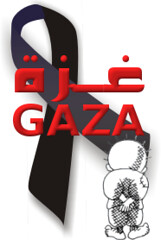Gaza victims' burns increase concern over phosphorus

The pale blue 155mm rounds are clearly marked with the designation M825A1, an American-made white phosphorus munition
Photographic evidence has emerged that proves that Israel has been using controversial white phosphorus shells during its offensive in Gaza, despite official denials by the Israel Defence Forces.
There is also evidence that the rounds have injured Palestinian civilians, causing severe burns. The use of white phosphorus against civilians is prohibited under international law.
The Times has identified stockpiles of white phosphorus (WP) shells from high-resolution images taken of Israel Defence Forces (IDF) artillery units on the Israeli-Gaza border this week. The pale blue 155mm rounds are clearly marked with the designation M825A1, an American-made WP munition. The shell is an improved version with a more limited dispersion of the phosphorus, which ignites on contact with oxygen, and is being used by the Israeli gunners to create a smoke screen on the ground.
The rounds, which explode into a shower of burning white streaks, were first identified by The Times at the weekend when they were fired over Gaza at the start of Israel's ground offensive. Artillery experts said that the Israeli troops would be in trouble if they were banned from using WP because it is the simplest way of creating smoke to protect them from enemy fire.
There were indications last night that Palestinian civilians have been injured by the bombs, which burn intensely. Hassan Khalass, a doctor at al-Shifa hospital in Gaza City, told The Times that he had been dealing with patients who he suspected had been burnt by white phosphorus. Muhammad Azayzeh, 28, an emergency medical technician in the city, said: “The burns are very unusual. They don't look like burns we have normally seen. They are third-level burns that we can't seem to control.”
Victims with embedded WP particles in their flesh have to have the affected areas flushed with water. Particles that cannot be removed with tweezers are covered with a saline-soaked dressing.
Nafez Abu Shaban, the head of the burns unit at al-Shifa hospital, said: “I am not familiar with phosphorus but many of the patients wounded in the past weeks have strange burns. They are very deep and not like burns we used to see.”
When The Times reported on Monday that the Israeli troops appeared to be firing WP shells to create a thick smoke camouflage for units advancing into Gaza, an IDF spokesman denied the use of phosphorus and said that Israel was using only the weapons that were allowed under international law.
Rows of the pale blue M825A1 WP shells were photographed on January 4 on the Israeli side of the Israel-Gaza border. Another picture showed the same munitions stacked up behind an Israeli self-propelled howitzer.
Confronted with the latest evidence, an IDF spokeswoman insisted that the M825A1 shell was not a WP type. “This is what we call a quiet shell - it is empty, it has no explosives and no white phosphorus. There is nothing inside it,” she said.
“We shoot it to mark the target before we launch a real shell. We launch two or three of the quiet shells which are empty so that the real shells will be accurate. It's not for killing people,” she said.
Asked what shell was being used to create the smokescreen effect seen so clearly on television images, she said: “We're using what other armies use and we're not using any weapons that are banned under international law.”
Neil Gibson, technical adviser to Jane's Missiles and Rockets, insisted that the M825A1 was a WP round. “The M825A1 is an improved model. The WP does not fill the shell but is impregnated into 116 felt wedges which, once dispersed [by a high-explosive charge], start to burn within four to five seconds. They then burn for five to ten minutes. The smoke screen produced is extremely effective,” he said.
The shell is not defined as an incendiary weapon by the Third Protocol to the Convention on Conventional Weapons because its principal use is to produce smoke to protect troops. However, Marc Galasco, of Human Rights Watch, said: “Recognising the significant incidental incendiary effect that white phosphorus creates, there is great concern that Israel is failing to take all feasible steps to avoid civilian loss of life and property by using WP in densely populated urban areas. This concern is amplified given the technique evidenced in media photographs of air-bursting WP projectiles at relatively low levels, seemingly to maximise its incendiary effect.”
He added, however, that Human Rights Watch had no evidence that Israel was using incendiaries as weapons.
British and American artillery units have stocks of white phosphorus munitions but they are banned as anti-personnel weapons. “These munitions are not unlawful as their purpose is to provide obscuration and not cause injury by burning,” a Ministry of Defence source said.
Mads Gilbert, a Norwegian war surgery specialist working in Gaza, told The Times that he had seen injuries believed to have resulted from Israel's use of a new “dense inert metal explosive” that caused “extreme explosions”. He said: “Those inside the perimeter of this weapon's power zone will be torn completely apart. We have seen numerous amputations that we suspect have been caused by this.”












